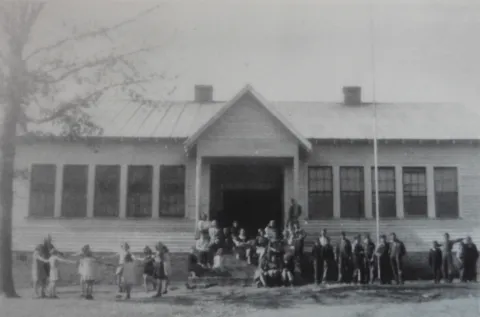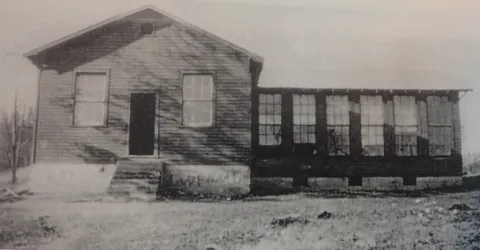Arevalo School in Big Ridge

Arevelo School, built around 1940
Big Ridge Elementary School opened in 1960-1961 as the consolidated school assigned to receive Pine Grove students. Central View, Hickory Valley, Arevalo, and part of Burkhart were also included in the consolidation.
Arevalo Elementary School opened to students in 1st through 8th grade circa1924. Bonnie Heiskell Peters relates the origins of the name of the Arevalo School in Union County Schoolday Memories.
Elvin Branum, a Union County Justice of the Peace, served on the Union County Court, better known today as Union County Commission. He named the school after his earlier experience in the Spanish American War in the Philippines. His company visited a peaceful village named Arevalo, which means “Christ Prepareth.” Since Branum had been instrumental in getting the school established, Superintendent W. H. Thomas asked him to name the school. So Union County had an elementary school that was named after a Pacific Island village.
Arevalo was located in the Big Ridge section of Union County in an area known as Pumpkin Center. By the 1930s, the enrollment increased and by the end of the decade, a bigger school was planned.
In 1937, W. W. Hill of Knoxville offered a bid of $950 to tear down the 1924 Arevalo School and construct a new building of wood on a brick or concrete foundation.
Apparently the blueprint called for new doors, but Hill stated that he would use doors from old buildings “regardless of that called for in the Blue Print.” His bid also noted the structure would be 60 feet in length by 42 feet in width.
By the early 1940s the wooden 1924 structure that resembled an L-shaped ranch house had been replaced by a structure that very much appears to be a Rosenwald School design. The school had two chimneys for the coal stove that was in each classroom. There was a separate outside door, side by side, in the front for each classroom. This building remained in use until the consolidation when students were transferred to Big Ridge School in 1960.
Recess offered the opportunity to play circle games and kickball. Children performed plays at Christmas that often told the story of the birth of Jesus. One year the students performed a Tom Thumb Wedding. Graduation from 8th grade was a major milestone event for the children and the community.
Some of the teachers were Dorothy Turner, Von Keller, Eula M. Troxler, Harriet G. Taylor, Lucy Jean Turner, Clifford Stooksbury, Claude Weaver, Gwen Hubbard Sharp, Ola Acuff Needham, Lewis Bridges, Wanda Woods Cox Byerley and Kathleen George Graves. The upper grade teacher usually served as the principal. Trula Berry and Stella Sharp were school cooks.
Wanda Woods Cox Byerley, who taught at Arevalo in 1955-1956, shared some memories of her experience. According to her, the original 1924 building was in Old Loyston. It was relocated on a hill behind Breeding’s Store, approximately a quarter mile south of the intersection of Hwy 61 and Hickory Valley Road when Norris dam was being built.
In 1939-1940, Union County built several schools, and she believes that was also when Arevalo was rebuilt. Arevalo had three classrooms, a kitchen and a hallway, but no indoor bathrooms. Wanda taught 25 4th and 5th grade students, 13 girls and 12 boys.
Gwen Hubbard Sharp had the 1st through 3rd and Doris Robb was the teaching principal with 6th through 8th grades. Facing the front door, the kitchen and Robb’s classroom was on the left with Sharp and Byerley on the right. When the school was vacated in 1960, the building became a private residence.
Wanda related that Stella Sharp was a good cook and that she could well remember smelling the pinto beans and meatloaf cooking while she taught. Wanda told that the children played fox and hound, hopscotch, marbles and some basketball and softball during recess.
She taught basic subjects but was able to independently plan her day. She recalled that most teachers did not have a bachelors degree but earned one over the years by attending summer classes at the University of Tennessee in Knoxville. She said some would teach for a while as they graduated high school and then use their money to go to school to be a nurse or take an office job.
School board members influenced the teacher assignments so some teachers got moved from school to school. This movement also caused some to find other employment.
David Coppock, along with his two brothers Glenn and Gerald, were students at Arevalo. David began in 1st grade at about 6 months past his fifth birthday and attended until about 3 months before the end of his 8th grade year. His father thought David had consumed enough cherry and apple pie, but needed to learn about the mathematical pi so he took him to another school to prepare him for high school math. Speaking of pie, David remembered how all of the food was hand prepared and cooked at the school. He could remember seeing the cook peel the potatoes because there were no frozen french fries. Food was cooked on a woodburning stove and lunch cost about 15 cents.
Ronnie Weaver, the son of Superintendent Claude Weaver, brought coal for the warm morning stoves and wood for the cookstove.
David Coppock recalled that when electricity came to the Big Ridge community in 1950, his family got an electric stove. They gave the woodstove to Arevalo School. This generosity afforded David a full year of free lunch.
Later in the 1950s Avondale Dairy delivered milk which cost one or two cents. But for a few years John Coppock's two sons, Leo and Theo, boarded the bus each morning with two stainless steel buckets with really tight lids. When the bus arrived at the school, the boys would hand over the buckets to the cook or a teacher. Some years there were three teachers and some years enrollment dropped and only two teachers were at Arevalo.
There was a well, but the pump was broken, so David and some other boys carried three gallon buckets of water from the spring. One of the teachers would bring a graniteware pitcher to pour the water into homemade paper cups. According to David, some children drank from the pitcher, and the teacher would take the pitcher home to give it a good washing before the next school year.
When David started his schooling, there was no school bus. Till Wyrick drove a workhand’s bus to Knoxville each day and traveled right by David’s house. So David's father paid Till fifty cents a week to drop David off at school each morning, then his dad would pick him up in the afternon. Much later Till remarried and his son, Rodney, was a student when David taught 8th grade at Big Ridge Elementary.
After 3rd grade, David rode a school bus owned by Burney George, a local store owner, near the school. David also remembered the Cas Breeding Store, whose father-in-law Tennie Stooksbury was the earlier store owner. This is the same store next to the theater where Clifford Stiner showed western movies.
The desks were slightly slanted wood tops on metal frames with a storage nook under the desktop for books. Desks were in rows one behind the other. The teachers and the students swept the classrooms. Some of the girls also helped serve lunch, especially to the younger children. There was no air conditioning. A county maintenance crew would oil the wood floors each year to preserve the wood and keep down the dust. Toilets were outside until the school closed in 1961.
David’s favorite game was fox and dog (hound). He shared how lunch was a whole hour. So the boys would eat quickly, then go outside to play. Half were foxes and chased the other half, which were the dogs. He told how sometimes they went a pretty good ways off the school property and sometimes did not return until nearly time to dismiss school. Another activity was playing basketball outside on an outside court.
David noted that he began school in 1946. He completed high school in 1960, and on June 10, 1960, entered East Tennessee State University in Johnson City with his good friend Johnny Walters to study business administration. He transferred to UT Knoxville in 1962. But he wavered so much back and forth between education and business courses that he did not have a degree after acquiring some 203 credit hours. Finally, after 45 more hours at Lincoln Memorial University in Harrogate, he graduated with a degree in business administration, education and economics.
At 20 years old he taught his first class at Big Ridge Elementary. He continued as a teaching principal for three years there. Then he returned to the classroom as a traveling reading teacher and a classroom teacher. He served as an elected superintendent and an appointed director.
He became a principal at Maynardville Elementary and Sharps Chapel Elementary. After his retirement, he was elected to the Union County Board of Education and as of August 31, 2024, he will have served the children and citizens of Union County for 61 years.
David Coppock, as many other successful people, started in a two-room rural school known as Arevalo—“Christ Prepareth.”
- Log in to post comments

Thank you, Marilyn! I really
Thank you, Marilyn! I really enjoyed reading this!